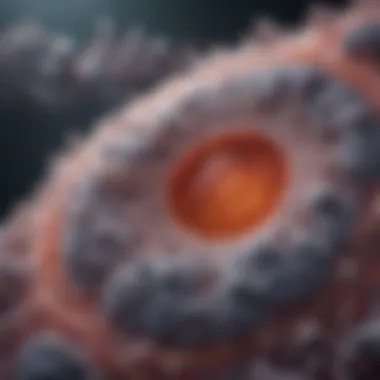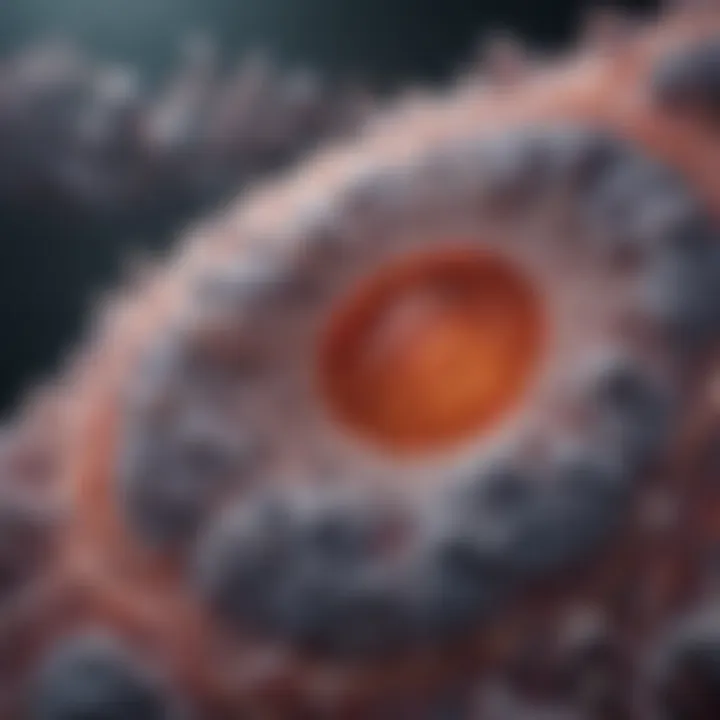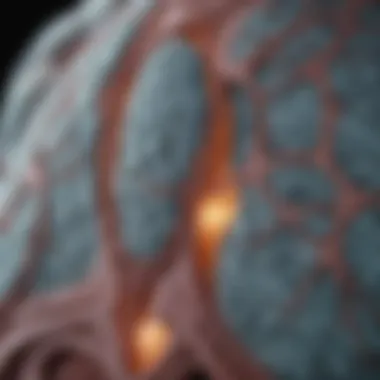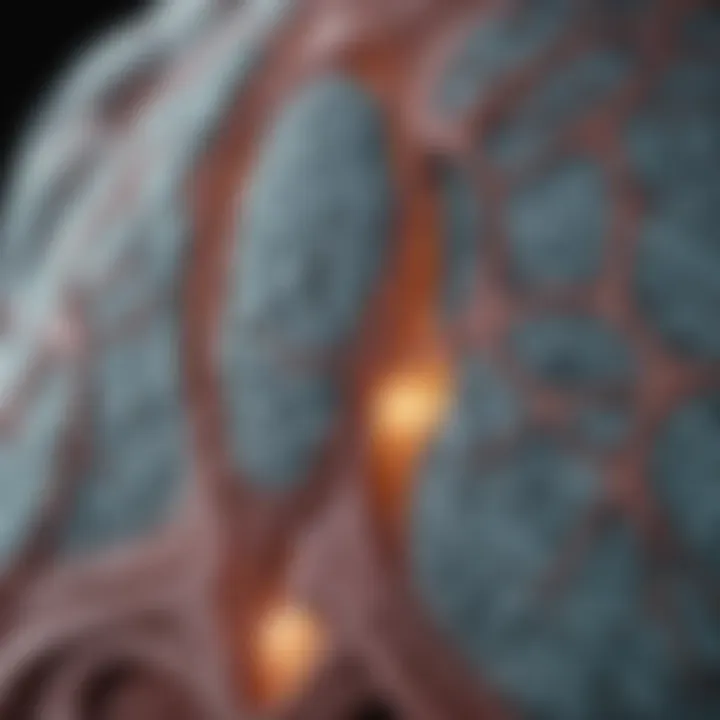Interstitial Infiltrates: A Comprehensive Overview


Intro
Interstitial infiltrates refer to accumulations and deposits of abnormal materials within the interstitium of the lungs. This phenomenon has significant implications for diagnosing various pulmonary diseases. Understanding these infiltrates is essential for students, researchers, educators, and healthcare professionals who specialize in respiratory health.
This article presents a comprehensive examination of interstitial infiltrates, focusing on their clinical relevance, the mechanisms behind their development, and the various diagnostic and treatment modalities available.
Research Overview
Methodological Approaches
Research in interstitial infiltrates employs a range of methodologies. Diagnostic imaging plays a critical role, with high-resolution computed tomography (CT) being a primary tool in identifying infiltrative patterns. Studies often involve clinical observation, pathology assessments, and the use of imaging results to correlate findings with clinical outcomes.
In addition, laboratory techniques such as pulmonary function tests help assess the impact of infiltrates on respiratory function. Furthermore, some research utilizes biopsies to analyze the tissue histology, providing deeper insight into the underlying conditions.
Significance and Implications
The understanding of interstitial infiltrates holds significant implications for patient care and treatment planning. These infiltrates may be indicative of broader pulmonary conditions such as interstitial lung disease, pneumonia, and even malignancies.
Awareness of the critical nature of interstitial patterns can lead to more accurate diagnoses, appropriate management strategies, and improved patient outcomes. Given the variety of conditions associated with these infiltrates, timely recognition by healthcare professionals is paramount.
Current Trends in Science
Innovative Techniques and Tools
Recent advancements in imaging technology have enhanced our ability to detect and characterize interstitial infiltrates. Innovations such as artificial intelligence are being integrated into imaging analysis, improving diagnostic accuracy and efficiency. Quantitative measures of lung lesions can now be obtained with advanced software, facilitating better interpretation of imaging results.
Additionally, the emergence of novel biomarker research may provide new avenues for understanding the etiology of these infiltrates and their relationship to specific diseases.
Interdisciplinary Connections
The study of interstitial infiltrates connects various disciplines, including respiratory medicine, radiology, and pathology. Collaborative approaches enable a more integrated understanding of the underlying mechanisms at work. For instance, insights from genetic research are now being incorporated into discussions of interstitial lung diseases. This cross-disciplinary dialogue enriches the knowledge base and encourages comprehensive treatment options.
Maintaining a broad view of interstitial infiltrates can lead to critical insights into health conditions, which is essential for informing patient management strategies.
Preamble to Interstitial Infiltrates
Understanding interstitial infiltrates is critical for those engaged in the field of pulmonary medicine. These infiltrates often signify an underlying pathological process that can lead to serious health issues. It is essential to grasp their implications in respiratory diseases, as they are not merely diagnostic findings but indicators of broader systemic ailments. This section aims to provide foundational insights into this complexity.
Definition and Context
Interstitial infiltrates refer to the accumulation of substances, often inflammatory cells, in the interstitial spaces of lung tissue. This condition can result from a variety of diseases, including infections, autoimmune disorders, and environmental exposures. The presence of infiltrates might suggest pulmonary edema, fibrosis, or even malignancy. To fully comprehend their significance, one must appreciate that interstitial tissues play a vital role in lung function and overall respiratory health.
The diagnostic approach for interstitial infiltrates often begins with imaging studies, where abnormalities are detectable. Understanding this context helps medical professionals in classifying and prioritizing further investigations. Given that the lung is a complex organ with multiple functions, interstitial infiltrates can significantly impact gas exchange, resulting in clinical manifestations that require immediate attention.
Importance in Pulmonary Medicine
Infectious and non-infectious diseases can lead to interstitial infiltrates. Their presence might indicate a severe underlying pathology, necessitating prompt intervention.
Recognizing and interpreting these infiltrates can enhance clinical decision-making. Key areas of importance include:
- Disease Identification: Initial assessment can guide physicians in identifying conditions such as sarcoidosis, pulmonary fibrosis, or interstitial lung disease.
- Prognostic Implications: The extent and pattern of infiltrates often correlate with disease severity and prospective outcomes, aiding in long-term management strategies.
- Treatment Planning: Understanding the type of infiltrate assists in developing appropriate treatment plans, whether they involve medications, therapies, or lifestyle changes.
Ultimately, interstitial infiltrates represent more than a mere radiological finding; they evoke a broader conversation about lung health and the body's responses to various pathological stimuli.
"Recognizing the intricacies of interstitial infiltrates can lead to better patient outcomes through timely interventions."
By deepening our understanding of interstitial infiltrates, we can focus efforts more effectively on preventative measures, early detection, and management of respiratory disorders. The subsequent sections of this article will explore these concepts in greater detail.
Pathophysiology of Interstitial Infiltrates
The pathophysiology of interstitial infiltrates is fundamental for understanding their implications in pulmonary medicine. It involves the mechanisms and processes that lead to the accumulation of inflammatory cells and fluid in the lung interstitium. This section delves into how these infiltrates form and the various conditions that trigger their emergence. A robust grasp of these elements aids healthcare professionals in diagnosing, treating, and managing pulmonary diseases effectively.
Mechanisms of Infiltration
Interstitial infiltrates arise through several intricate mechanisms. The primary mechanism is inflammation, which can be due to various reasons. When the lungs experience damage or infection, they respond, leading to an increase in vascular permeability. This response allows fluid and immune cells to penetrate the interstitium, resulting in an inflammatory process.
In cases of hypersensitivity, exposure to allergens can elicit an overactive immune response, leading to significant infiltration of lymphocytes and other immune cells. The role of cytokines, which are signaling molecules, cannot be understated as they mediate the inflammatory response and attract further immune cells to the site.
Understanding these mechanisms provides clarity on why certain conditions lead to interstitial infiltrates. For instance, infections like pneumonia or conditions such as sarcoidosis can originate from diverse biological insults, each prompting a specific response within the lung tissue. This knowledge is essential for developing targeted therapies.


Underlying Causes
The causes of interstitial infiltrates are varied and can be categorized into infectious and non-infectious factors. Infectious causes include viral, bacterial, and fungal infections. For example:
- Viral Infections: Influenza and respiratory syncytial virus can lead to significant interstitial involvement.
- Bacterial Infections: Streptococcus pneumoniae can also induce a response that appears as infiltrates on imaging.
- Fungal Infections: Histoplasmosis and others may result in chronic infiltrative processes.
Non-infectious causes are equally important and include environmental exposures, drug reactions, and autoimmune conditions. Inhalation of substances such as dust or toxic fumes can provoke reactive inflammation, leading to chronic interstitial conditions.
Additionally, diseases like rheumatoid arthritis and systemic lupus erythematosus contribute to the development of infiltrates by causing systemic inflammation. Awareness of these underlying causes enables clinicians to explore appropriate treatment pathways effectively.
Understanding the underlying causes of interstitial infiltrates is essential for effective treatment and management strategies.
Clinical Manifestations
Understanding the clinical manifestations of interstitial infiltrates is crucial for several reasons. It offers a glimpse into the underlying pathophysiological processes affecting pulmonary function. Clinical manifestations can guide healthcare professionals in making accurate diagnoses and selecting appropriate treatment strategies. Recognizing these symptoms early can significantly impact patient outcomes. Furthermore, awareness of complications arising from infiltrates can lead to more informed discussions between healthcare providers and patients. This section delves into both the symptoms associated with infiltrates and the potential complications that may arise, providing insight into the clinical relevance of interstitial infiltrates.
Symptoms Associated with Infiltrates
When evaluating interstitial infiltrates, a range of symptoms often presents. These symptoms can vary significantly from one individual to another. Commonly reported signs include:
- Cough: This may be dry or productive. A chronic cough often raises concern for lung conditions.
- Dyspnea: Patients commonly experience shortness of breath or difficulty breathing, especially during exertion.
- Chest pain: Discomfort or pain in the chest area can also be reported and should be evaluated further.
- Fatigue: Many individuals with interstitial infiltrates report an unusual level of tiredness.
Each of these symptoms can signal a change in pulmonary health. The presence of these symptoms, particularly dyspnea, is often a significant marker for the severity of the infiltrate.
Complications Arising from Infiltration
Interstitial infiltrates can lead to several complications, especially if not addressed promptly. The possibility of these complications underscores the need for early recognition and intervention. These complications can include:
- Respiratory Failure: In severe cases, infiltrates can impair gas exchange, leading to respiratory distress or failure. This is a life-threatening condition requiring immediate medical attention.
- Progressive Pulmonary Fibrosis: Chronic inflammation may lead to scarring of lung tissue, resulting in pulmonary fibrosis. This can significantly affect lung capacity and function over time.
- Hypoxemia: Infiltrates may reduce oxygen levels in the blood, leading to low oxygen saturation levels, which can impact overall health and function.
- Infection: Areas of infiltrated lung tissue may be more susceptible to infections due to impaired immune response in the affected regions.
Recognizing early clinical signs and understanding potential complications are vital for managing interstitial infiltrates effectively.
In summary, the clinical manifestations present a spectrum of symptoms and complications that highlight the importance of timely diagnosis and intervention. Identifying these features can elucidate the underlying disease processes influencing pulmonary health and help optimize patient management.
Diagnostic Techniques
The significance of accurate diagnostic techniques in the study of interstitial infiltrates cannot be overstated. These techniques enable healthcare professionals to differentiate between various pulmonary conditions, guiding effective treatment strategies. Due to the non-specific nature of symptoms associated with interstitial infiltrates, employing a combination of imaging and laboratory diagnostics is critical for effective patient management.
Imaging Modalities
X-rays
X-rays play a fundamental role in the assessment of interstitial infiltrates. They provide an initial overview of lung architecture and are often the first imaging study performed when pulmonary disease is suspected. The key characteristic of X-rays is their ability to quickly visualize areas of opacification, indicating possible infiltrative processes. This rapid assessment makes X-rays a beneficial choice in emergency settings or when time is of the essence.
However, the limitations of X-rays must be noted. They can miss subtle changes that may be crucial for diagnosis. Furthermore, interpretation can be subjective, which can lead to variations in diagnosis among different professionals. Overall, while they are not a comprehensive diagnostic tool, they serve well as a starting point in the evaluation of interstitial infiltrates.
CT Scans
Computed Tomography (CT) scans offer a more detailed view compared to X-rays. They are instrumental in delineating the extent and precise location of interstitial infiltrates. The key advantage of CT scans is their ability to produce cross-sectional images, enabling better visualization of lung structures. This level of detail makes CT a popular choice for further investigation after initial X-rays.
Nonetheless, the use of CT scans presents some drawbacks, such as exposure to higher doses of radiation. Furthermore, they can sometimes result in finding incidentalomas, which may lead to unnecessary anxiety and follow-up procedures. Despite these concerns, the enhanced clarity provided by CT scans significantly contributes to the overall assessment and management strategy for patients suspected to have interstitial infiltrates.
MRI Techniques
Magnetic Resonance Imaging (MRI) is less commonly utilized compared to both X-rays and CT scans in assessing interstitial infiltrates. However, MRI is notable for its capability to evaluate soft tissue contrast more effectively. This attribute is particularly useful in certain cases, such as when assessing concomitant conditions affecting the pleura or mediastinum. The key characteristic of MRI is its absence of ionizing radiation, which enhances safety for patients who require frequent follow-up imaging.
That said, MRIs are often expensive and less accessible in many medical settings. The longer time required for MRI scans can also be a significant disadvantage, particularly in acute situations. Therefore, while MRI can add valuable insights in specific cases, its practicality in the routine evaluation of interstitial infiltrates is limited.
Laboratory Tests
Biopsy Procedures
Biopsy procedures serve as an essential diagnostic tool for accurately identifying the underlying pathology of interstitial infiltrates. They involve obtaining a tissue sample directly from the lung, allowing for a definitive histological diagnosis. The key characteristic of biopsy procedures is their ability to provide detailed cellular information, which is critical in distinguishing between various interstitial lung diseases.
However, biopsies carry risks such as bleeding and infection. They can also be invasive and not suitable for all patients. Overall, while biopsy procedures are invaluable for precise diagnosis, they should be considered in the context of individual patient circumstances.
Blood Tests
Blood tests contribute to the assessment of interstitial infiltrates by providing ancillary information about the patient's health status. They can reveal underlying systemic illnesses, such as autoimmune conditions or infections, that could be causing or exacerbating lung infiltrates. The convenience of blood tests is their non-invasiveness and the speed of obtaining results, making them a quick screening method.
Differential Diagnosis


Differential diagnosis plays a critical role in understanding interstitial infiltrates. This process involves distinguishing between various conditions that present similar clinical features. Such differentiation is essential to initiate appropriate treatment strategies, as some conditions require radically different approaches. Misdiagnosing an infiltrate can lead to inappropriate treatments, which may exacerbate the patient's condition.
It is also important to recognize that interstitial infiltrates can arise from a wide range of underlying diseases. Recognizing these complexities is crucial for clinicians. By acknowledging symptoms and verifying with advanced diagnostic tools, healthcare professionals can provide better care.
Common Conditions Mimicking Interstitial Infiltrates
Several conditions can resemble interstitial infiltrates, complicating diagnosis. Some prevalent conditions include:
- Pulmonary Edema: Fluid buildup in alveoli can mimic infiltrative patterns seen in interstitial lung diseases.
- Pneumonia: Inflammatory responses can produce similar radiographic findings that appear as infiltrates.
- Fibrosis: Conditions such as idiopathic pulmonary fibrosis can appear functionally similar.
- Sarcoidosis: This granulomatous disease can produce nodular infiltrates and opacity on imaging.
Each of these conditions has its own pathophysiology and treatment implications. Understanding these similarities and differences is vital for effective clinical practice.
Identifying Specific Pathologies
Identifying specific pathologies involves a multi-faceted approach that includes imaging, histological evaluation, and clinical inquiry. Here are some methods to assist in identification:
- Imaging Techniques: High-resolution CT scans can provide detailed views of lung structure and help distinguish between infiltrative diseases.
- Biopsy Procedures: When imaging is inconclusive, obtaining tissue samples is essential. This step provides definitive information about underlying conditions.
- Clinical History: A thorough patient history can reveal important clues about exposure risks or pre-existing conditions that might explain the infiltrate.
The differential diagnosis of interstitial infiltrates is not just about identifying disease. It is about ensuring the best outcomes for patients through accurate detection and tailored interventions.
Treatment Options
The treatment options available for interstitial infiltrates are crucial for managing symptoms and addressing the underlying causes of pulmonary conditions. It is essential for healthcare providers to be well-versed in both pharmacological and non-pharmacological approaches. This section aims to explore the various treatment strategies, outlining their benefits, limitations, and overall impact on patient outcomes.
Pharmacological Interventions
Corticosteroids
Corticosteroids are among the most commonly used medications for treating interstitial infiltrates. Their primary aspect is their anti-inflammatory property, which effectively reduces inflammation within the lungs. The main characteristic of corticosteroids is their ability to rapidly alleviate symptoms in many patients with breathing difficulties. This makes them a favored choice in clinical practice.
A unique feature of corticosteroids is their success in treating various conditions, including idiopathic pulmonary fibrosis and sarcoidosis. Their advantage lies in their quick response time in diminishing lung inflammation. However, prolonged use can lead to side effects, such as increased susceptibility to infections and potential long-term complications.
Antibiotics
Antibiotics play a significant role in the treatment of interstitial infiltrates, particularly when an infectious agent is suspected as a contributing factor to lung infiltration. They are essential in empirically treating pneumonia and other bacterial infections impacting the lungs. The key characteristic of antibiotics is their efficacy against specific pathogens, making them a popular choice in the management of pulmonary diseases.
A distinct advantage of antibiotics is their ability to prevent further complications arising from secondary infections. However, the inappropriate use of antibiotics can lead to resistance, which posits a disadvantage in the management of interstitial infiltrates, emphasizing the need for careful patient assessment.
Immunosuppressants
Immunosuppressants are an important consideration in treating certain interstitial lung diseases, especially when the inflammation is due to an autoimmune process. These drugs target immune responses that might be causing lung damage. A key characteristic of immunosuppressants is their role in reducing the body's immune reaction, which can help in managing conditions like systemic sclerosis.
The unique feature of immunosuppressants is their ability to stabilize various chronic inflammatory conditions. Their advantage lies in controlling symptoms and preventing further lung damage. Nonetheless, a significant disadvantage is the increased risk of infections due to suppressed immune functions, requiring close monitoring of patients on these medications.
Non-Pharmacological Approaches
Non-pharmacological approaches serve as valuable adjuncts to traditional medical therapies. These strategies can optimize lung function and enhance quality of life for patients.
Oxygen Therapy
Oxygen therapy is fundamental for patients experiencing low oxygen levels due to interstitial infiltrates. Its primary aspect involves delivering supplemental oxygen to improve blood oxygen saturation. The main characteristic of oxygen therapy is its ability to provide immediate relief for breathlessness. This makes it a beneficial option within this clinical context.
One unique aspect of oxygen therapy is its adaptability; it can be administered in various settings, including at home or in hospitals. The advantage lies in its immediate benefit for patients suffering from acute respiratory distress. However, dependence on supplemental oxygen might limit a patient's mobility and independence, which is a consideration for ongoing management.
Pulmonary Rehabilitation
Pulmonary rehabilitation focuses on comprehensive strategies for improving the functional capacity of patients with chronic respiratory diseases. This intervention includes exercise training, education, and counseling to empower patients. The key characteristic of pulmonary rehabilitation is its multidisciplinary approach, addressing both physical and psychological aspects of lung health, making it a beneficial choice in management plans.
The unique feature of pulmonary rehabilitation is its capacity for creating tailored programs for individual patient needs, thus optimizing recovery potential. Its advantages encompass not only improved lung function but also enhanced overall well-being. However, access to comprehensive rehabilitation programs may vary, which can limit patient participation in some regions.
Prognosis and Outcomes
Understanding the prognosis and outcomes of interstitial infiltrates is crucial in the management of pulmonary conditions. The prognosis can vary significantly based on various factors like the underlying cause of the infiltrates, the patient's overall health, and the response to treatment. This section will delve into the specific elements influencing prognosis and outline long-term management strategies that healthcare professionals can adopt to ensure better patient outcomes.
Factors Influencing Prognosis
Several key factors shape the prognosis for patients with interstitial infiltrates. These factors can include:
- Underlying Disease: The specific condition causing the infiltrates, such as idiopathic pulmonary fibrosis or autoimmune disorders, plays a significant role. Each disease presents different challenges and prognostic implications.
- Severity of Infiltration: Diagnosis through imaging studies like CT scans can help define the extent of the infiltrates. More extensive infiltration often correlates with worse outcomes.
- Patient’s Age and Comorbidities: Older patients or those with significant comorbid conditions, such as cardiovascular diseases, may face a poorer prognosis due to decreased overall resilience.
- Response to Treatment: How well a patient responds to initial treatment regimens can be indicative of longer-term outcomes. Those who show improvement tend to have a better prognosis.


"The multifactorial nature of interstitial infiltrates means understanding these dynamics is key to predicting outcomes effectively."
Long-Term Management Strategies
Effective long-term management is crucial in improving the prognosis of patients with interstitial infiltrates. Some useful strategies may include:
- Regular Monitoring: Continuous assessment of lung function allows clinicians to detect changes early. Pulmonary function tests and periodic imaging can guide adjustments in treatment.
- Patient Education: Informing patients about their condition fosters adherence to treatment protocols and empowers them to recognize symptoms of deterioration promptly.
- Tailored Pharmacotherapy: Selecting the right medications, such as corticosteroids or immunosuppressants, based on individual patient needs can mitigate symptoms and prevent progression.
- Lifestyle Modifications: Encouraging lifestyle changes, including smoking cessation and nutritional support, can enhance lung health and overall well-being.
- Supportive Care Services: Integrating support from respiratory therapists or nutritionists can provide holistic care tailored to individual needs.
In summary, understanding the prognosis and outcomes of interstitial infiltrates allows for better management and improved healthcare delivery. Identification of factors influencing prognosis coupled with effective long-term strategies can lead to enhanced patient care and improved outcomes.
Research and Future Directions
Research in the domain of interstitial infiltrates is critically important for continuous advancement in pulmonary medicine. The evolving understanding of interstitial diseases necessitates ongoing exploration to enhance diagnostic accuracy and treatment efficacy. As healthcare providers strive for improved patient outcomes, research initiatives play a vital role in identifying emerging treatment modalities and refining existing diagnostic techniques.
Investments in research for interstitial infiltrates can yield several benefits, including:
- Development of Novel Therapies: Uncovering new pharmacological and non-pharmacological approaches can lead to significant improvements in patient care.
- Enhanced Diagnostic Tools: Innovations in imaging and laboratory techniques can facilitate earlier and more precise identification of interstitial lung diseases.
- Understanding Disease Mechanisms: Research contributes to a deeper comprehension of the underlying pathophysiology, aiding in targeted treatment strategies.
Furthermore, interdisciplinary collaboration among researchers, clinicians, and patients is essential. Such cooperation encourages the sharing of knowledge, fostering innovative thinking and comprehensive strategies for tackling the challenges posed by interstitial infiltrates.
"Research is crucial; it opens doors to understanding and overcoming the complexities of pulmonary diseases."
Emerging Treatment Modalities
Emerging treatment modalities signify a pivotal aspect of managing interstitial infiltrates and related pulmonary conditions. Current research focuses on several innovative approaches that have the potential to reshape therapeutic landscapes.
- Targeted Therapies: Recent studies examine molecular pathways involved in fibrosis and inflammation, leading to the design of therapies that precisely target these mechanisms. Agents such as nintedanib and pirfenidone provide hope in managing diseases like idiopathic pulmonary fibrosis.
- Cell-Based Therapies: Cellular therapies, including stem cell treatments, are being investigated for their potential to repair lung tissue. These modalities may prove beneficial in reversing damage caused by chronic interstitial diseases.
- Immunomodulators: The role of the immune system in interstitial lung diseases is gaining attention. Research on various immunomodulators aims to reduce inflammation and enhance lung function.
- Gene Therapy: Advances in gene editing technologies suggest future possibilities for correcting genetic defects that contribute to pulmonary conditions.
These emerging modalities underscore the necessity for continued research and clinical trials. It is essential to evaluate their effectiveness and safety in diverse patient populations.
Innovations in Diagnostic Techniques
Advancements in diagnostic techniques are crucial for the timely identification and management of interstitial infiltrates. Several innovations enhance the ability to diagnose accurately.
- High-Resolution Computed Tomography (HRCT): This imaging modality provides detailed visualization of lung structures, allowing for better identification of abnormal patterns associated with interstitial diseases.
- Bronchoscopy with Endoscopic Ultrasound: This technique enables tissue sampling from the lungs with improved accessibility and precision, aiding in diagnosis.
- Artificial Intelligence (AI) in Imaging: The integration of AI algorithms in radiology assists in analyzing vast amounts of imaging data. AI can enhance the accuracy of detecting interstitial infiltrates and distinguishing between different types of lung diseases.
- Biomarkers in Blood Tests: Emerging research investigates blood-based biomarkers that can indicate inflammation or fibrotic processes. These developments may allow for simpler, non-invasive diagnostic approaches.
These innovations have the potential to significantly improve clinical outcomes by enabling earlier interventions and more tailored treatment plans.
Patient Education and Support
Patient education and support play a crucial role in managing interstitial infiltrates. Understanding the nature of these infiltrates empowers patients to engage actively in their health care. Knowledge helps them make informed decisions about their treatment pathways, medications, and lifestyle adjustments. Moreover, education demystifies complex medical jargon, fostering a more collaborative relationship with healthcare providers. Emphasizing proactive management can lead to better outcomes and improved quality of life.
When patients are well-informed, they are more likely to adhere to treatment plans, recognizing the importance of each component in managing their condition. They often find empowerment in understanding their symptoms, which allows for timely reporting of changes to their healthcare team. In this context, education is not merely a transfer of information, but a vital tool for navigating their health journey.
Resources for Patients
Accessing reliable resources is critical for patients dealing with interstitial infiltrates. Several options exist to enhance their understanding and management of the condition:
- Patient Support Groups: Organizations such as the American Lung Association offer community support.
- Educational Websites: Websites like Wikipedia and Britannica provide comprehensive information.
- Healthcare Provider Resources: Direct communication with healthcare professionals can lead to tailored materials designed specifically for patient needs.
- Online Forums: Platforms like Reddit host discussions among patients, discussing personal experiences and coping strategies.
These resources equip patients with the information necessary to understand their condition better and seek assistance when needed. They can learn about the latest research, treatment options, and practical tips for managing symptoms effectively.
Support Systems
Support systems are essential for patients affected by interstitial infiltrates. They provide emotional, social, and practical assistance necessary for coping with the condition’s challenges. Consider the following key support structures:
- Family and Friends: Having a support network can alleviate feelings of isolation. Loved ones can offer encouragement and assist in daily tasks if needed.
- Professional Counseling: Professional mental health support can address anxiety or depression that may arise from living with a chronic illness.
- Healthcare Team: A coordinated approach involving pulmonologists, nurses, and respiratory therapists ensures comprehensive care tailored to individual patient needs.
"Support systems address not only the physical aspects of care but also the emotional and psychological dimensions, fostering resilience among patients."
Being embedded in supportive structures enhances a patient’s ability to manage their health. With these systems in place, patients can navigate the complexities of their condition more effectively and with greater assurance.
Culmination
The conclusion serves as a vital summary of the information presented in this article, emphasizing the significance of interstitial infiltrates in pulmonary medicine. Throughout the discussion, we have explored the various facets of interstitial infiltrates, including their pathophysiology, clinical manifestations, diagnostic techniques, treatment options, and prognosis. Understanding these infiltrates is crucial for healthcare professionals, as they are often indicative of underlying pulmonary conditions that can significantly impact patient outcomes.
Summary of Key Points
In this article, we have covered important aspects related to interstitial infiltrates:
- Definition: Interstitial infiltrates refer to the abnormal accumulation of fluid or cells in the lung interstitium, which can arise from various conditions.
- Pathophysiology: The mechanisms of infiltration can be inflammatory, infectious, or neoplastic in nature, each presenting unique challenges in diagnosis and treatment.
- Clinical Manifestations: Various symptoms may arise, such as cough, dyspnea, and decreased oxygen saturation.
- Diagnostic Techniques: Multiple imaging modalities like X-rays and CT scans, alongside laboratory tests, help elucidate the nature of infiltrates.
- Treatment Options: A combination of pharmacological and non-pharmacological interventions is often necessary for managing conditions associated with infiltrates.
- Research Directions: Continuous research seeks to improve therapeutic approaches and enhance diagnostic accuracy.
Final Remarks on Interstitial Infiltrates
In summary, interstitial infiltrates are more than just radiological findings; they represent a crucial aspect of pulmonary pathology that requires careful evaluation. As our understanding of these conditions evolves, so does our approach to managing them. Healthcare professionals must remain aware of the latest advancements in diagnostic techniques and treatment methodologies to provide optimal care.
Recognizing the complex interplay of causes and effects related to interstitial infiltrates enhances the ability to predict outcomes and tailor interventions for individual patients. The relevance of this topic extends beyond the confines of medical textbooks; it shapes clinical practice and ultimately impacts patient health on a profound level.



